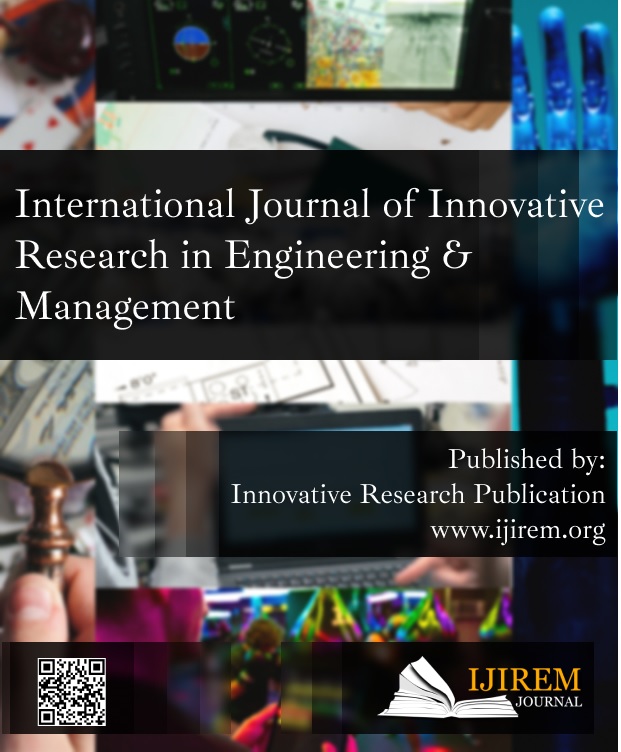Novel Design of Power Generation Using Windmill in Integration with Biomass Energy System
Keywords:
Windmill, Biomass, Fossil energy, Hybrid, Energy, Municipal, Solid wasteAbstract
More than two billion people living in underdeveloped countries, the bulk of whom reside in rural areas, do not have access to electricity. Kerosene and animal dung are used to provide many of the region's energy needs in addition to traditional and non-electric energy sources, such as human and animal muscle power. There has been a rise in recent years in environmental concerns due to fossil fuel consumption and the global warming phenomenon. For these reasons, renewable energy hybrids have been proposed as a possible option. Wind energy is supposed to contribute to the global state of the environment because of its purity. Also, every year, metric tons of residential garbage is collected, mostly being dumped in spread areas. In India, paper and plastic make up the majority of municipal solid waste (MSW), accounting for 80 percent of total MSW. Using anaerobic digestion or direct combustion, the waste of the municipality can be transformed into power for use. Employing a windmill to power a biomass generator is the topic of this paper. For a windmill that operates on an intermittent basis, a sufficient number of battery banks are installed. Biomass and windmills are used to generate electricity, and a battery bank can also be employed to store excessive and deficit power. All of the biomass generator's operations can be scheduled to save on costs. As part of this article, a compact wind farm with biomass energy and a battery backup is described. Proficient assessments of a wind-bio energy hybrid power plant with an output of 6 kW are provided. The paper's goal is to determine the feasibility of the system and optimize it.
Downloads
References
Koroneos C, Spachos T, Moussiopoulos N. Exergy analysis of renewable energy sources. Renew Energy 2003;28(2):295– 310
Akella AK, Saini RP, Sharma MP. Social, economical and environmental impacts of renewable energy systems. Renewable Energy 2009;34:390–6.
Alberg Ostergaard P, Mathiesen BV, Moller B, Lund H. A renewable energy scenario for Aalborg Municipality based on low-temperature geothermal heat, wind power and biomass. Energy 2010;35:4892–901.
Lund H, Munster E. Management of surplus electricity production from a fluctuating renewable-energy source. Appl Energy 2003;76:65–74.
Droste-Franke B, Paal B, Rehtanz C, Sauer D, Schneider J P, Schreurs M, et al. Demand for balancing electrical energy and power. Balancing renewable electricity. Berlin, Heidelberg: Springer; 2012.
Ostergaard PA, Lund H. A renewable energy system in Frederikshavn using low-temperature geothermal energy for district heating. Appl Energy 2011;88:479–87.
Fraunhofer-Gesellschaft. Managing renewable energy intelligently. ScienceDaily. www.sciencedaily.com/releases/2014/03/140325094814.htm [accessed 07.2.21].
Ostergaard PA. Comparing electricity, heat and biogas storages’ impacts on renewable energy integration. Energy 2012;37:255–62.
Reddy AKN, Krishnaswamy KN. Innovation chain under the impact of technology imports. Lecture 3(a), R&D Management Course of Department of Management Studies. Bangalore: Indian Institute of Science; 1988
Chanakya HN, Reddy BVV, Modak J. Biomethanation of herbaceous biomass residues using 3-zone plug flow like digesters—a case study from India. Renewable Energy 2009;34:416–20
G. Liu, M.G. Rasul, M.T.O. Amanullah, M.M.K. Khan, Feasibility study of standalone PV-wind-biomass hybrid energy system in Australia, in: Power Energy Eng. Conf. (APPEEC), 2011 Asia-Pacific, 2011, pp. 1–6.
P. Balamurugan, S. Ashok, T.L. Jose, An optimal hybrid wind-biomass gasifier system for rural areas, Energy Sources 33 (Part A) (2011) 823–832, https://doi.org/ 10.1080/15567030903117646.
J. Soares, A.C. Oliveira, Numerical simulation of a hybrid concentrated solar power / biomass mini power plant, Appl. Therm. Eng. (2016), https://doi.org/10.1016/j. applthermaleng.2016.06.180.
A. Singh, P. Baredar, Techno-economic assessment of a solar PV, fuel cell, and biomass gasifier hybrid energy system, Energy Rep. 2 (2016) 254–260, https://doi. org/10.1016/j.egyr.2016.10.001.
S. Singh, M. Singh, S. Chandra, Feasibility study of an
islanded microgrid in rural area consisting of PV, wind, biomass and battery energy storage system, Energy Convers. Manage. 128 (2016) 178–190, https://doi.org/10.1016/j.enconman. 2016.09.046.
A. Raheem, M.Y. Hassan, R. Shakoor, Pecuniary optimization of biomass/wind hybrid renewable system, in: 1st Int. e-Conference Energies, 2014, pp. 1–10.
A. Baghernejad, M. Yaghoubi, K. Jafarpur, Exergoeconomic comparison of three novel trigeneration systems using SOFC, biomass and solar energies, Appl. Therm. Eng. 104 (2016) 534–555, https://doi.org/10.1016/j.applthermaleng.2016.05.032.
Chaurasiya, P. K., Warudkar, V., & Ahmed, S. (2019). Wind energy development and policy in India: A review. Energy Strategy Reviews, 24, 342–357
Bildirici, M. E. (2013). Economic growth and biomass energy. Biomass and Bioenergy, 50, 19– 24. doi:10.1016/j.biombioe.2012.09.055
Pérez-Navarro, A., Alfonso, D., Álvarez, C., Ibáñez, F., Sánchez, C., & Segura, I. (2010). Hybrid biomass-wind power plant for reliable energy generation. Renewable Energy, 35(7), 1436–1443. doi:10.1016/j.renene.2009.12.018
IS/IEC 61724:1988, Indian standard Photovoltaic system performance monitoring-guidelines for measurement, data exchange and analysis.
Overend RP. Biomass for Energy, Energy Studies Review, 1989; 1(1) Article 2.<http://digitalcommons.mcmaster.ca/esr/vol1/iss1/2>
Bolyos E, Lawrence D, Nordin A. Biomass as an energy source: the challenges and the path forward, http://www.ep.liu.se/ecp/009/003/ecp030903.pdf [accessed February, 2009].
Kaygusuz K, Turker MF. Biomass energy potential in Turkey. Renew Energy 2002;26:661–78.
Veringa HJ. Advanced techniques for generation of energy from biomassand waste.
